This post may contain affiliate links, from which we earn an income. Click here to read our affiliate policy.
The blue eyes of Albania are two of the country’s best-known natural phenomenon, and rightly so! With the clearest water in every shade of blue and green that we have ever seen, a visit to one or both of Albania’s blue eyes will be a highlight of your trip.
We spent three months exploring Albania, road tripping from north to south. Both blue eyes offer different experiences, and in this guide, we’re going to share top tips about how to visit and what to expect when you get there. Make sure to pack your swimmers, a dip in an Albanian blue eye is an adventure you won’t want to miss!
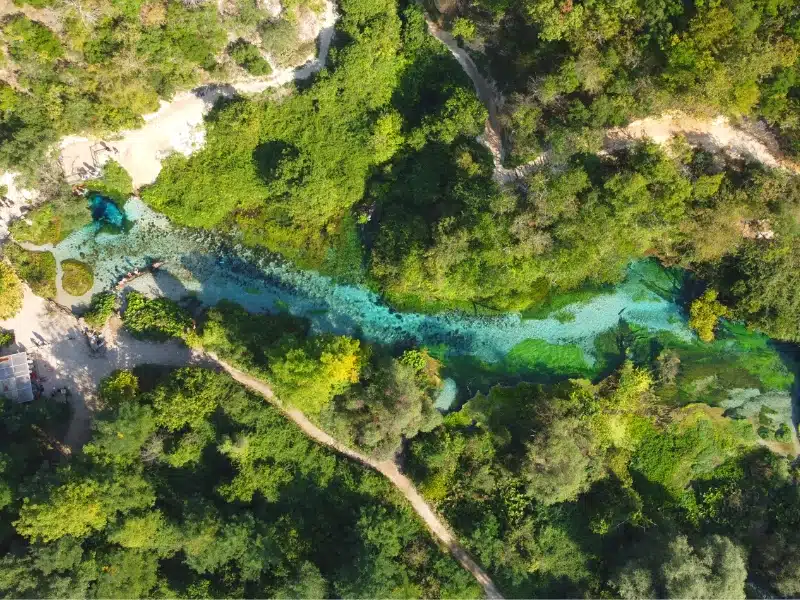
What is a Blue Eye in Albania?
A blue eye or Syri i Kaltër is a natural spring or water source in karst rock that looks like an actual blue eye from above. The inner dark ‘pupil’ is created by the depth of the spring or well, while the outer brightly colored ‘iris’ comes from the surrounding shallower water.
The Sarandë Blue Eye has a vertical karst spring of unknown as its source, whereas the Theth Blue Eye is fed from a waterfall along the Kaprreja River, which cascades into a limestone pool.
Albania Blue Eyes Map
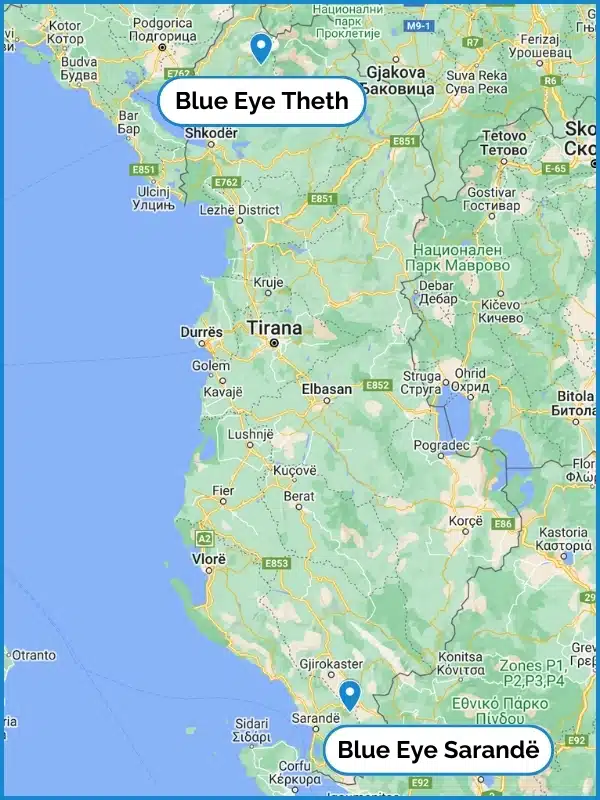
Make sure you have travel insurance you can trust when visiting Albania. We recommend True Traveller for their 5-star TrustPilot reviews, variety of cover options, best activities cover as standard, great prices, and excellent service.
Sarandë Blue Eye
The original and famous blue eye spring is the Sarandë Blue Eye (or Syri i Kaltër in the Albanian language) in the village of Muzinë in the Finiq municipality, between the coastal town of Sarandë (also called Saranda) and Gjirokaster in southern Albania.
Described by Lonely Planet as a ‘magical place’, the spring has a fast discharge rate of 18400 liters per second. Divers have descended as far as 50 meters into the karst hole from which the spring flows, but it is unknown how deep the source actually goes underground, and some say there may even be an underground cave!
There is a local legend of the Blue Eye that says the pool is actually the crying eye of a giant snake that crossed the entire mountain range and left his eye when it fell in the location of today’s Blue Eye.
Before any tourists visited Albania’s Blue Eye, the place was known as the springs of Bistricë, the source of the 25 km Bistricë River which flows into the Ionian Sea off the Albanian Riviera. For many years during the Communist regime, only the dictator Enver Hoxha and his party officials were allowed to swim in the Blue Eye.
Today, the Sarandë Blue Eye is the main attraction in the south of the country, and the immediate surrounding area of Mali i Gjere is a designated Natural Monument characterized by sycamore trees and oak trees which grow happily alongside palm trees and tropical plants. Oh, and there’s another seventeen natural springs to explore in the Blue Eye National Park!
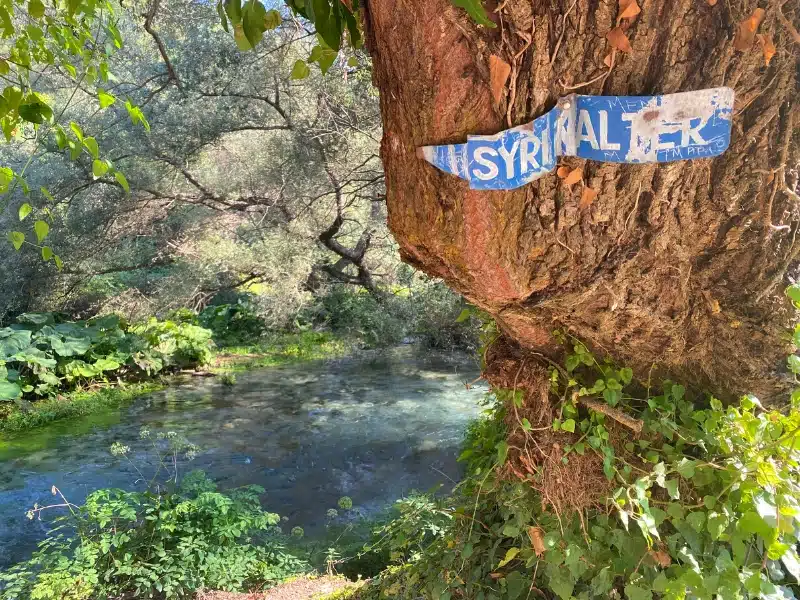
Blue Eye Sarandë Opening Times
The Sarandë Blue Eye is open from 7am to 7pm every day of the year.
Blue Eye Sarandë Ticket Prices
A ticket to the Blue Eye at Sarandë costs 50LEK (£0.40/$0.50). If you need to park, it costs 100LEK (£0.80/$1) which you pay at the booth in the car park. You can only pay in cash for tickets and parking.
The Best Time to Visit Sarandë’s Blue Eye
A popular option due to its ease of access, thousands of people visit the Blue Eye every year and it can get very busy in the summer months – there’s nothing like a refreshing dip in the crystal clear waters on a hot day!
We visited in October, when the weather was still warm but visitor numbers are fewer. Alongside September, April, and May, the shoulder seasons are a good time to visit – you’ll still have good weather, the hike will be a bit cooler, and the crowds of summer will be gone.
RELATED POST: Is Albania Safe? A Comprehensive Guide for Adventurous Travelers
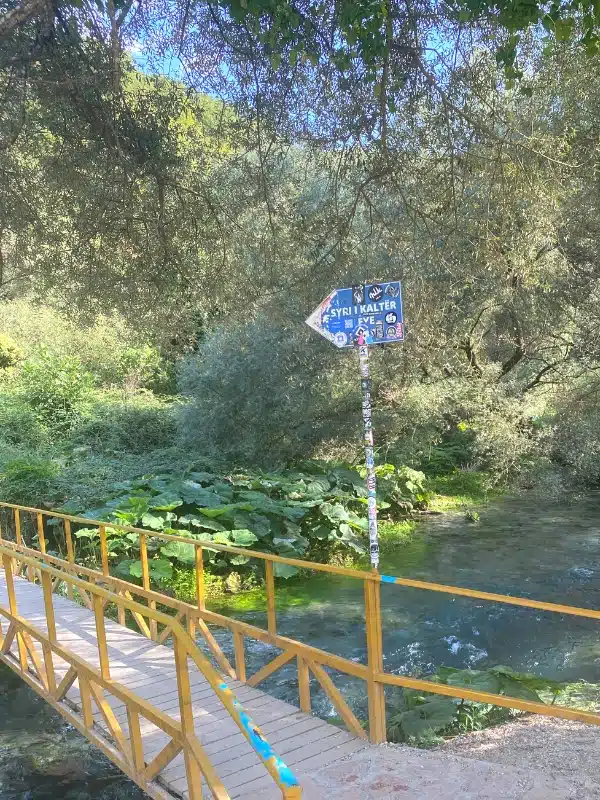
Getting to Sarandë’s Blue Eye
If you’re driving in Albania, the SH99 from Sarandë takes you through spectacular countryside on twisting roads to the Blue Eye, close to the small village of Krongj. If you have a hire car, the drive will take you around 40 minutes. From Gjirokaster, the same SH99 main road will take around an hour to drive.
If you want to take public transport, there are regular buses past the Blue Eye along the same main highway from Sarandë and Gjirokaster.
Take any bus heading to Tirana, Berat or Gjirokaster from the bus stop opposite Friendship Park on Rruga Flamurit in Sarandë, or any bus heading to Sarandë from the Gjirokaster Bus Terminal. Let the bus driver know to stop at the Blue Eye, and hop off at the parking lot there.
There are also regular furgon mini-buses and a privately run shuttle service from Sarandë to the Blue Eye, the KMG Blue Eye shuttle service. This is a good option if you’re tight for time and only want to spend a few hours at the Blue Eye. You could also ask your accommodation to organize a taxi for you, but this is the most costly option.
There are also several well-rated and recommended day trips from Tirana, which often include a second activity along Albania’s southern coast, helping you to see more of Albania in less time and making the extra cost worthwhile. Here are our top picks:
The official Blue Eye car park has been connected to the Blue Eye in the past year by a paved and tarmacked road. You can’t drive along this road, but there are places around the entrance and car park where you can hire electric bikes and scooters if you don’t fancy the 30 minute 1.7 km walk from the car park.
If you’re traveling in a camper, or want to pitch a tent, you can stay overnight in the parking area for a small fee. There is also an easily accessible field next to the car park with river views, which you can find on Park4Night.
Once you pass the toilets towards the end of the paved road (in a modern building but not an experience I’d want to repeat!), there is a little restaurant floating above the water serving grilled meats and Albanian beer, and then you cross a bridge to the path along the river, before arriving at the Blue Eye.
RELATED POST: Albanian Road Trip: Epic One Week Itinerary
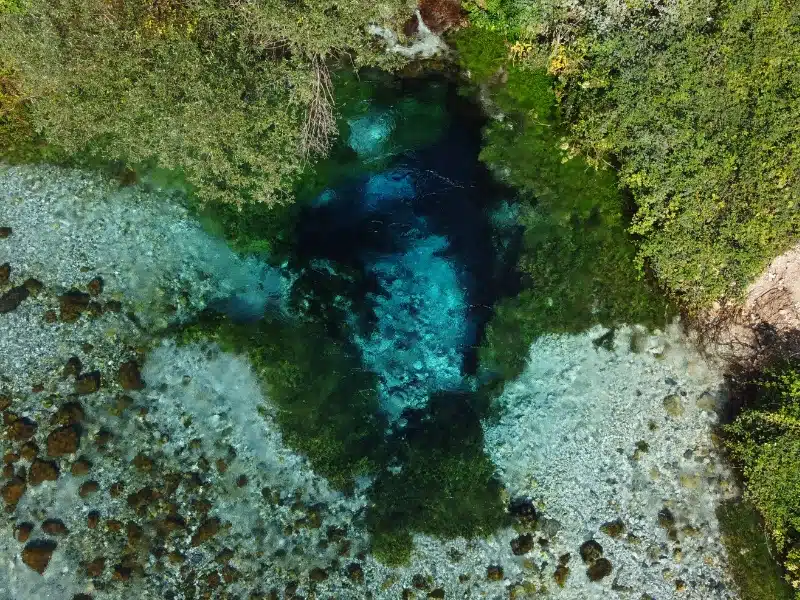
What to Expect at the Sarandë Blue Eye
Once you cross the bridge, you’ll be on a sandy woodland path that runs alongside the river as it meanders from the Blue Eye.
As you look right, your first glimpse of the water will take your breath away. Clear, sparkling, and in hues of bright blue, turquoise, and green, you’ll want to jump in there and then!
Just a few meters away is the Blue Eye, a natural pool around 80 meters square. On the far side is a viewing platform, which is also a de facto diving board. Closer to the path is a small souvenir shop, an information board, and a few makeshift changing cubicles.
Surrounding the fresh water pool is lush greenery, some fallen trees that make good seats, and a few areas where you can get into the water. It’s quite shallow around the edges of the pool, but as you get closer to the eye itself, you can feel the force of the current rushing up from the underwater spring.
You can even fill your water bottles here, the spring is a major sourch of drinking water in the area.
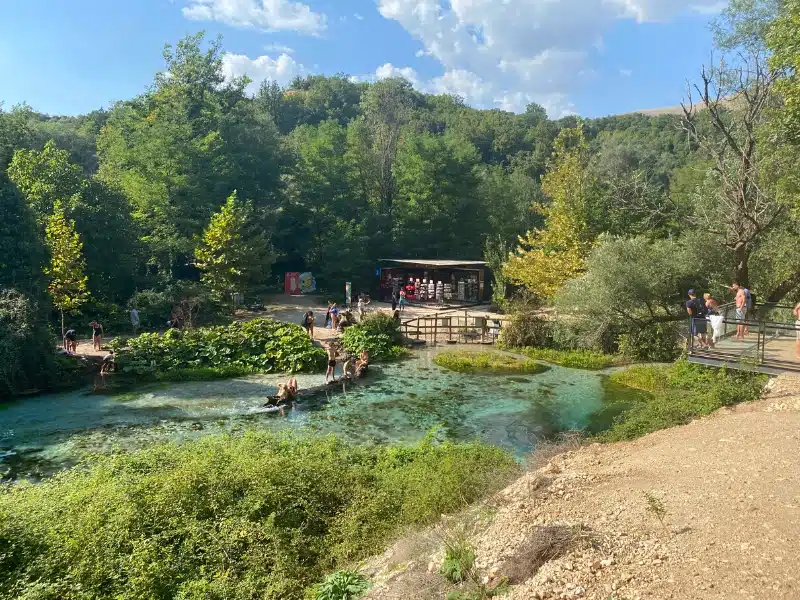
Swimming at Sarandë’s Blue Eye
Since 2022, signs have gone up to forbid swimming. Many of the access points have been blocked off, but it is still possible to get into the water and we didn’t see any officials there to prevent swimming.
There is a platform on the far side of the spring where people jump off into the water, but be careful if you do, as the high pressure of the spring water rushing up can push you easily along the river into deeper waters.
The water temperature is around 10° Celsius/50° Fahrenheit year-round. The ice-cold water certainly feels freezing, so perhaps have a dip to acclimatize before jumping off the platform!
RELATED POST: Things to Do in Albania: 18 Amazing Highlights Worth Visiting
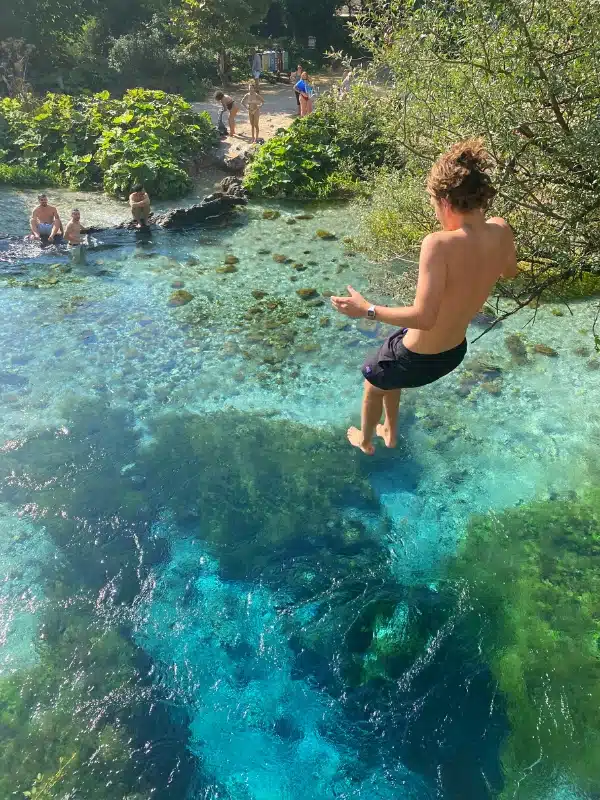
Looking for the best SIM card deals in Europe for your trip? Check out our guide to the best data SIMs in Europe and get the best deal for your trip to Albania.
Albania Blue Eye of Theth
High in the remote Albanian Alps, Theth’s Blue Eye is fed by a waterfall on the Limi i Zi or Kaprreja River, which flows into the limestone pool. The Theth Blue Eye is fast becoming as popular as the Sarandë Blue Eye, although it is a bit more off the beaten path and does take a bit more effort to visit.
Surrounded by the so-called Accursed Mountains, many people visit this region for the famous Valbona to Theth hike, as well as the nearby Grunas Waterfall along the Shales River, which merges further east into the Black Drin.
If you take the round trip from Shkodër on the Lake Koman ferry, which connects the towns of Koman and Fierzë, you can make a four day and three night loop, closing the circle by taking the stunning day hike from Valbona to Theth, and then on to the Theth Blue Eye, before returning along the exciting SH21 new road.
RELATED POST: Beautiful Albania: 16 Most Scenic Places to Visit
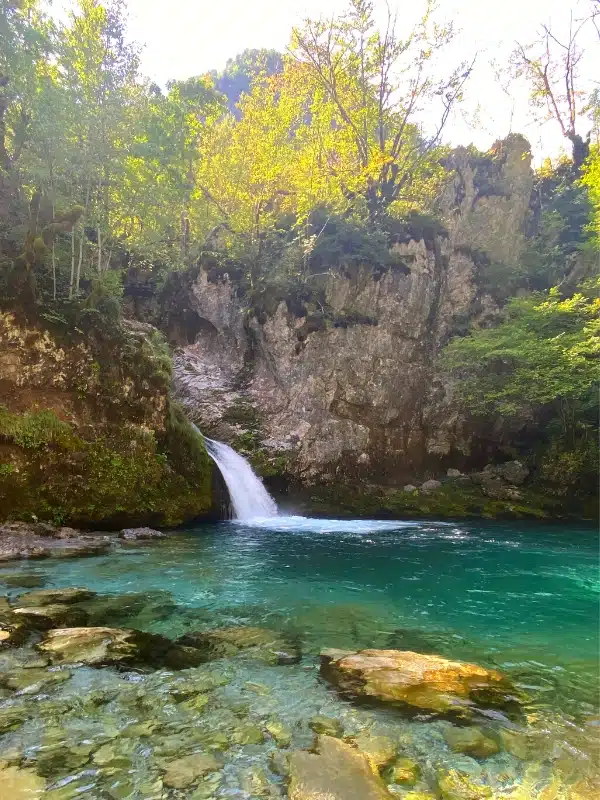
Blue Eye Theth Opening Times
The Theth Blue Eye is open all day every day, it never closes.
Blue Eye Theth Ticket Prices
There is no cost to visit and swim in the Blue Eye at Theth, but you will have to pay 500LEK (£4/$5) in cash to park if you take a hire car.
The Best Time to Visit Theth’s Blue Eye
Just like the Syri i Kalter, the Blue Eye in Theth is a popular tourist destination that gets very busy in summer. Late spring, early summer, and fall are a good time to visit – you’ll still have mild weather, the hike will be a bit easier, and the crowds of summer will be gone.
Visiting in spring will also reward you with a bigger flow and a larger waterfall, as the high water from snow melt makes its way down the surrounding mountains.
You won’t be able to get to Theth much before May because the road is closed during the winter months and cannot be used until the snow clears in late spring.
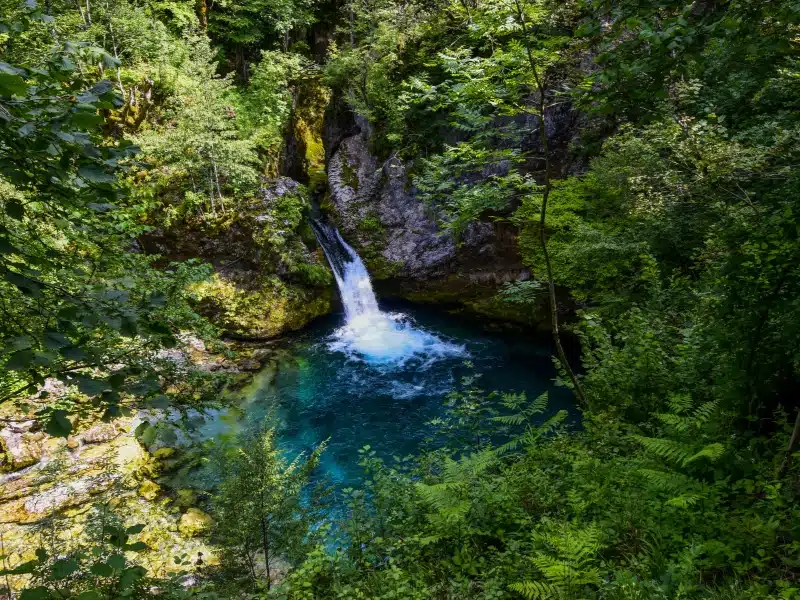
Getting to Theth’s Blue Eye
The easiest way to get to Theth’s Blue Eye is to drive the 20 minute paved road to the car park at the trailhead.
You can also hire a taxi from Theth to Nderlysaj village and they will drop you at the starting point of the hike and wait until you return. Make sure to agree on the waiting time and cost of the return trip with the taxi driver in advance.
If you can hire a 4×4 taxi, they will take you along the first kilometer of the route to the start of the dirt track, which is way to narrow for cars and cannot be avoided!
Many people take the 9.7 mile/15.6 km hike from Theth to the famous pool, which takes approximately six hours there and back. The route follows the surprisingly busy road all the way, with the river on one side of the road and high cliffs on the other.
At the trailhead, there are a few restaurants and bars overlooking the river, before you cross the Ndërlysaj Bridge to pick up the 30-40 minute Vaskat Ndërlysaj hiking trail through the woods that surround the whole area.
The 2.5 km route is well-traveled and follows a flat path for a kilometer or so before you start to gain elevation on a narrow dirt track through the trees. This track undulates a fair bit, and there are rocks, steps, and tree routes to negotiate, and if it’s been raining it can be slippery – I guess what I’m saying is, wear decent walking shoes or sturdy trainers.
You can take a tent and stay at the small meadow campsite en route to the Blue Eye, or if you’re in a camper, you can stay overnight in the car park or one of the many other areas nearby.
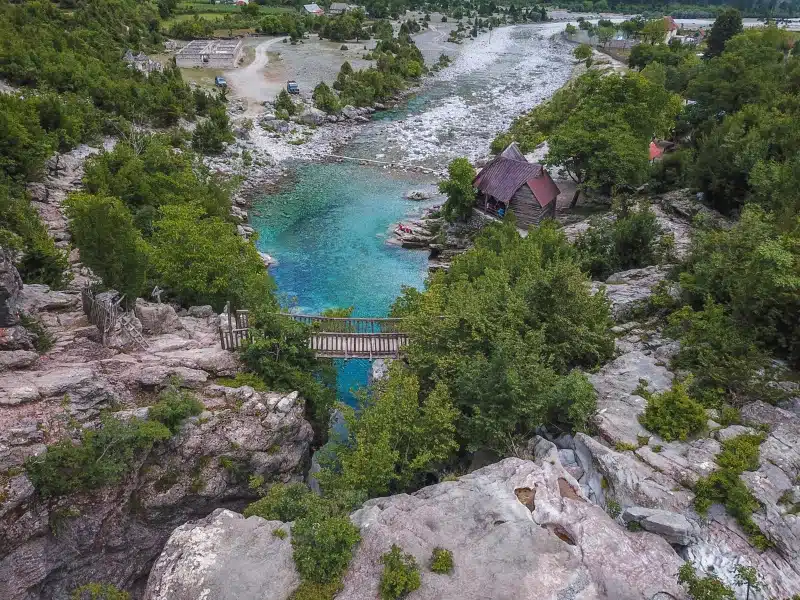
If getting to Theth feels too difficult or you don’t have much time, you could take a multi-day guided tour from Tirana where you also get to see other highlights of the region. Here are our top picks:
What to Expect at the Theth Blue Eye
The final stretch of the path takes you down to the turquoise water, through wild ferns, over some large rocks, and a few muddy stretches. The pool, which is surrounded by vegetation, is 4-5 meters at its deepest point, and around 100 meters square.
The waterfall is about 3 meters high, not quite the magnificent cascade described elsewhere online, but nevertheless very pretty. The whole area feels a bit like a tropical paradise, just without the parrots!
There are various rocks and wooden boards (not always in good condition) to help you cross from the hiking path to the rickety ladder up the cliff to a wooden platform and some small restaurants, or to the side of the pool opposite the waterfall, from where you can swim.
We also enjoyed the so-called ‘moon pools’, which can be found to the left of the path over the Ndërlysaj Bridge, close to the parking lot. These pools have been carved out of the karst landscape over millennia, leaving behind a natural playground of shallow clear blue waters, rushing chutes, and turquoise blue pools.
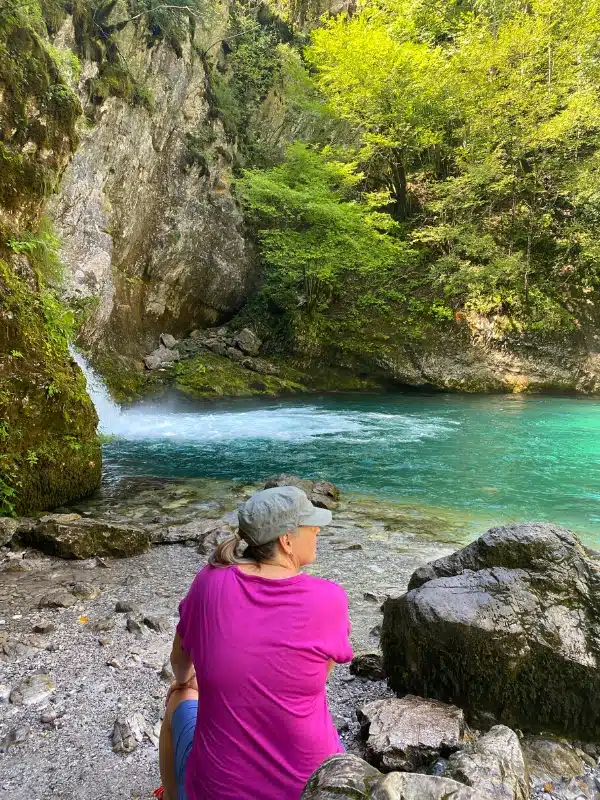
Swimming at Theth’s Blue Eye
It’s easy to swim in the Blue Eye’s waters here, there are no signs forbidding it and access is relatively easy. The best way to get in is to cross the river at the pool and swim from the large flat rocks.
There are no areas to change here, so wear your swimmers under your hiking gear, bring a large towel or hide in the surrounding vegetation!
You might only want a quick swim as the water temperature is very cold at 10-13° Celsius/50-55° Fahrenheit year-round. As the river is always moving, there is not much opportunity for the water to warm up.
Although a few brave people were swimming, it was too cold for me and the closest I got to getting wet was dipping my toes in the moon pools!
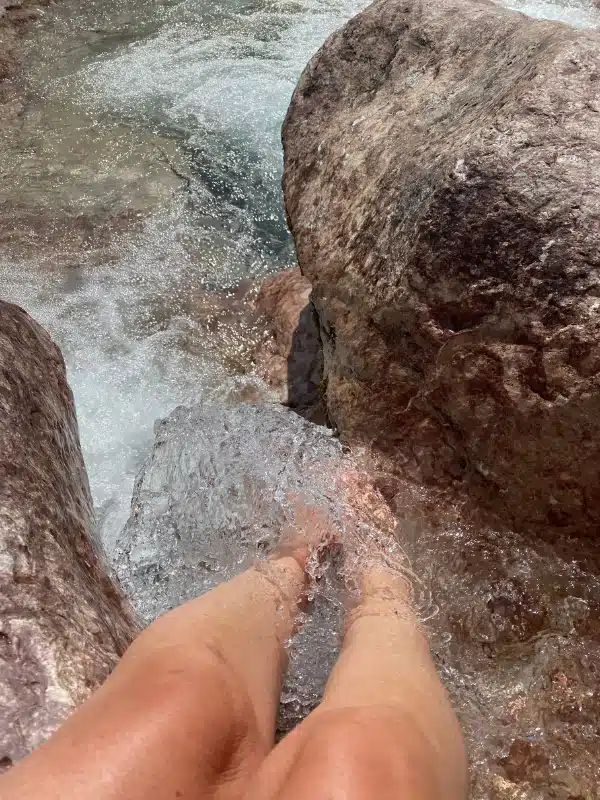
Blue Eye Essentials
Both of Albania’s beautiful Blue Eyes do need you to walk to get there. For the Sarandë Blue Eye, with its paved access road, trainers or sandals will be fine. For the hike to the Blue Eye at Theth, more sturdy trainers or walking shoes are a better option.
Make sure to carry water and maybe a few snacks, although both places do have cafés and restaurants. On the Theth hike, there is also a small kiosk on the route where you can buy cold drinks. You’ll need cash to buy food and drink in both locations.
If you’re planning to swim, you should also bring your swimmers and towel, plus a dry bag for your wet gear and something warm to wear when you get out of the water.
A drone, GoPro, and camera or phone will help you capture all those amazing Insta-worthy images.
Looking for more European travel ideas? Check out these top posts…
European Road Trip: Six Countries in 90 Days
Norway Road Trip: Four Unmissable Routes
Germany Road Trip: 8 Unmissable Routes
The Perfect Andalucia Road Trip: 10-14 Day Itinerary
The Ultimate Bucket List Italy Road Trip
Spring Road Trip from Britain to Portugal
Love it? Pin it!
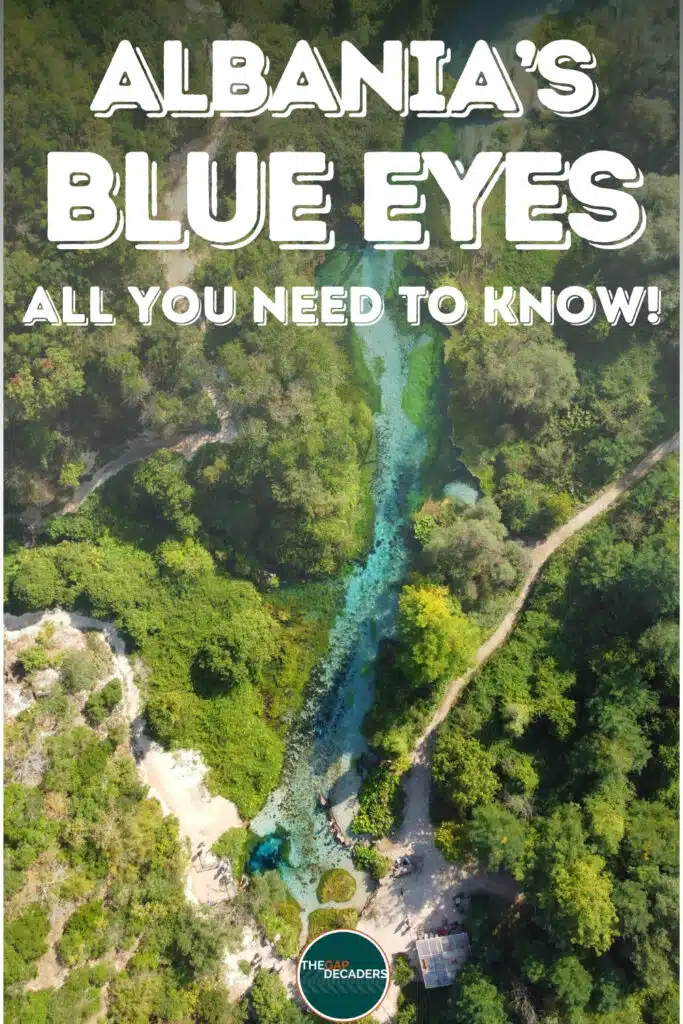
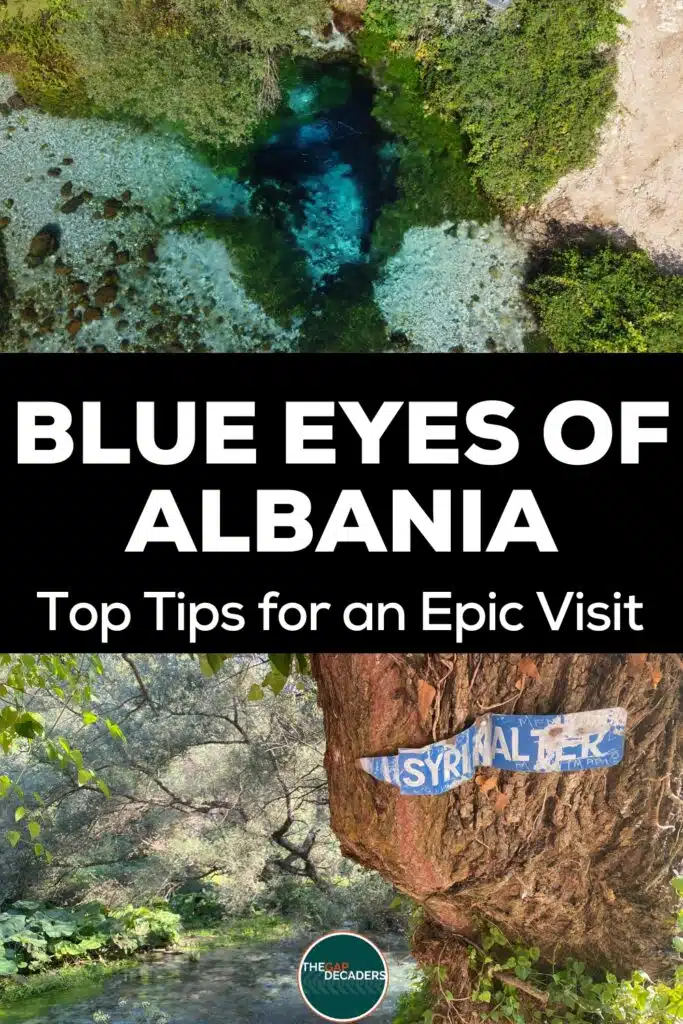

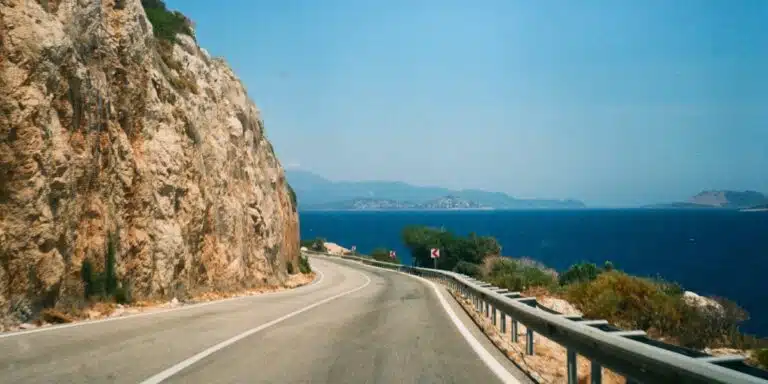

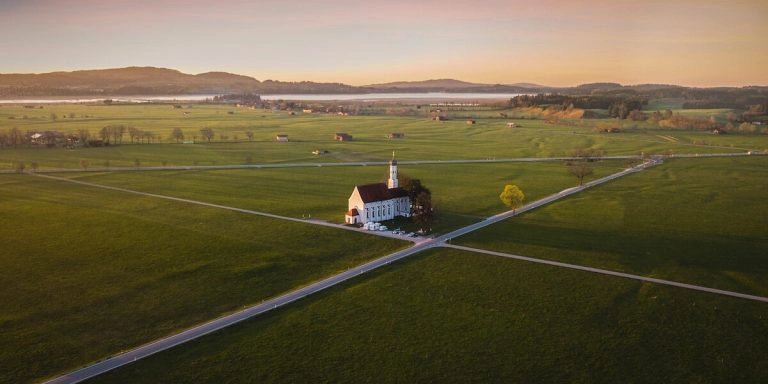
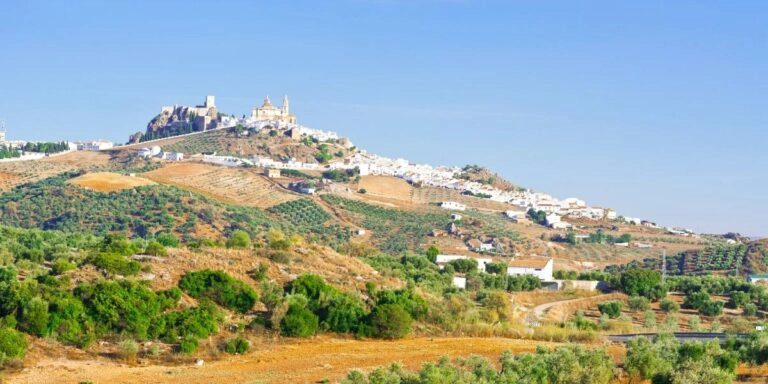
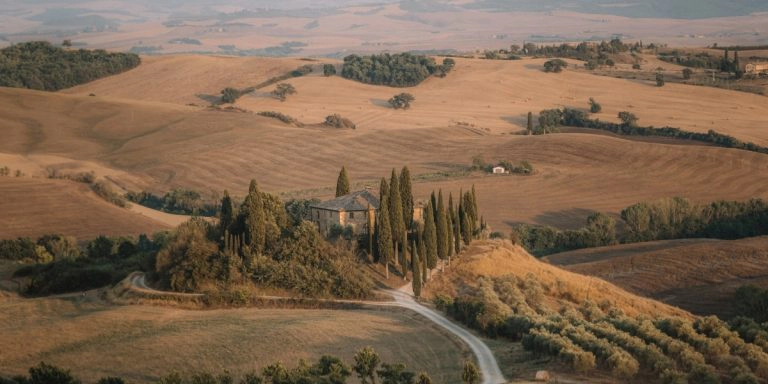
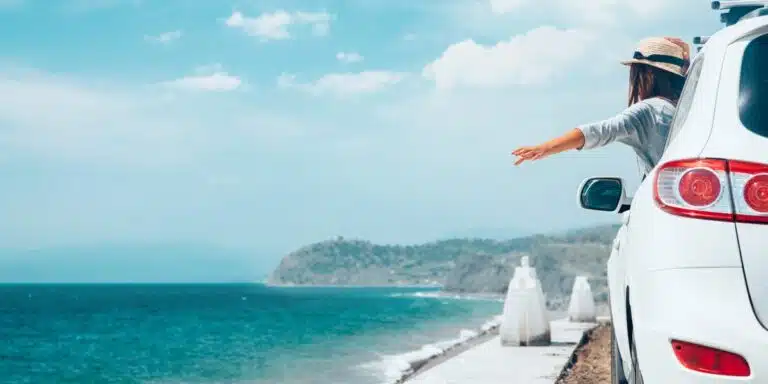
Hi there yep, the water is very cold and obviosuly you need to be able to swim, but no special prep is required. Just don’t forget your swimmers and a towel! Izzy
also, remember to respect the nature around, the blue eye is a real gem and we gotta make sure it remains that way for years to come!
Good question, Maddie524! I visited there last summer, and no special gear was needed for a quick dip, but definitely keep the cold in mind. The water is crystal clear but super cold.
hey, was wondering if the special gear is needed for swimming at Sarande’s Blue Eye? read about its cold water & depth, seems a bit intimidating without the right prep. thanks for the insights, Izzy Nicholls, really intrigued by this spot!